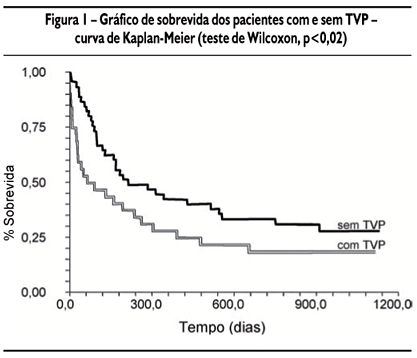PURPOSE: To evaluate Doppler Ultrasound (DUS) in oncology patients suspected of having Deep Venous Thrombosis (DVT) and correlate findings with their clinical characteristics and outcome. METHODS: A study was made with 96 consecutive oncology patients submitted to DUS suspected to have DVT between May 2001 and April 2002. The same radiologist examined 73 women and 23 men, with a median age of 58 years, using DUS equipment, with high frequency linear and convex probes (logic500 - GE and HDI5000 - Philips). RESULTS: In 42 (43.8%) patients the DUS was considered normal, in 33 (34.4%) DVT was diagnosed and 21 of them had superficial or previous deep venous thrombosis or non conclusive studies. Considering clinical evaluation (and death by PE as caused by DVT) as the gold standard, DUS sensitivity was of 95.9%. There was a statistically significant correlation between DVT and tumor stage at the time of initial diagnosis and patient's survival rate (p<0.05). There was no correlation between DVT and gender, age, type of malignancy, stage of disease at the time of DVT diagnosis and different treatment regimens. CONCLUSION: It was concluded that in cancer patients DUS has a high sensitivity for diagnosis of DVT and that DVT diagnosis in these patients correlates with a shorter overall survival. Since there are no reliable clinical predictors to identify cancer patients with DVT, DUS should be performed whenever DVT is suspected.
Venous thrombosis; Neoplasms; Risk factors



